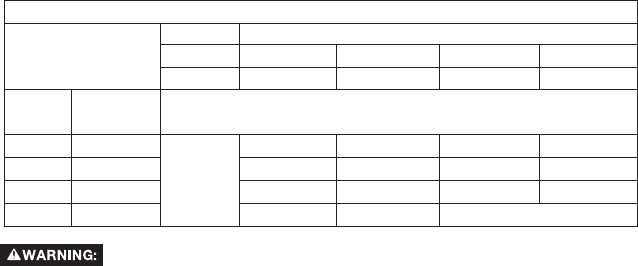
7
p) Do not use accessories that require liquid coolants. Using water or other liquid
coolants may result in electrocution or shock.
KICKBACK AND RELATED WARNINGS
Kickback is a sudden reaction to a pinched or snagged rotating wheel, backing pad,
brush or any other accessory. Pinching or snagging causes rapid stalling of the rotating
accessory which in turn causes the uncontrolled power tool to be forced in the direction
opposite of the accessory’s rotation at the point of the binding.
For example, if a backing pad is snagged or pinched by the workpiece, the edge of the
pad that is entering into the pinch point can dig into the surface of the material causing
the wheel to climb out or kick out. The wheel may either jump toward or away from the
operator, depending on direction of the wheel’s movement at the point of pinching.
Kickback is the result of power tool misuse and/or incorrect operating procedures or
conditions and can be avoided by taking proper precautions as given below.
a) Maintain a firm grip on the power tool and position your body and arm to allow
you to resist kickback forces. Always use auxiliary handle, if provided, for maximum
control over kickback or torque reaction during start-up. The operator can control
torque reactions or kickback forces, if proper precautions are taken.
b) Never place your hand near the rotating accessory. Accessory may kickback over
your hand.
c) Do not position your body in the area where power tool will move if kickback
occurs. Kickback will propel the tool in direction opposite to the wheel’s movement at
the point of snagging.
d) Use special care when working corners, sharp edges etc. Avoid bouncing and
snagging the accessory. Corners, sharp edges or bouncing have a tendency to
snag the rotating accessory and cause loss of control or kickback.
e) Do not attach a saw chain woodcarving blade or toothed saw blade. Such
blades create frequent kickback and loss of control.
SAFETY WARNINGS SPECIFIC FOR SANDING OPERATIONS:
a) Do not use excessively oversized sanding disc paper. Follow manufacturer’s
recommendations when selecting sanding paper. Larger sanding paper extending
beyond the sanding pad presents a laceration hazard and may cause snagging,
tearing of the disc or kickback.
EXTENSION CORD
An extension cord must have adequate wire size (AWG or American Wire
Gauge) for safety. The smaller the gauge number of the wire, the greater the
capacity of the cable, that is 16 gauge has more capacity than 18 gauge. An under-
sized cord will cause a drop in line voltage resulting in loss of power and overheat-
ing. When using more than one extension to make up the total length, be sure each
individual extension contains at least the minimum wire size. The following table
shows the correct size to use depending on cord length and nameplate ampere
rating. If in doubt, use the next heavier gauge. The smaller the gauge number, the
heavier the cord.
Minimum Gauge for Cord Sets
Ampere Rating
Volts Total Length of Cord in Feet (meters)
120V
25 (7.6) 50 (15.2) 100 (30.5) 150 (45.7)
240V
50 (15.2) 100 (30.5) 200 (61.0) 300 (91.4)
More
Than
Not More
Than
AWG
0 6 18 16 16 14
6 10 18 16 14 12
10 12 16 16 14 12
12 16 14 12 Not Recommended
Some dust created by power sanding, sawing, grinding, drilling, and other
construction activities contains chemicals known to the State of California to cause cancer,
birth defects or other reproductive harm. Some examples of these chemicals are:


















